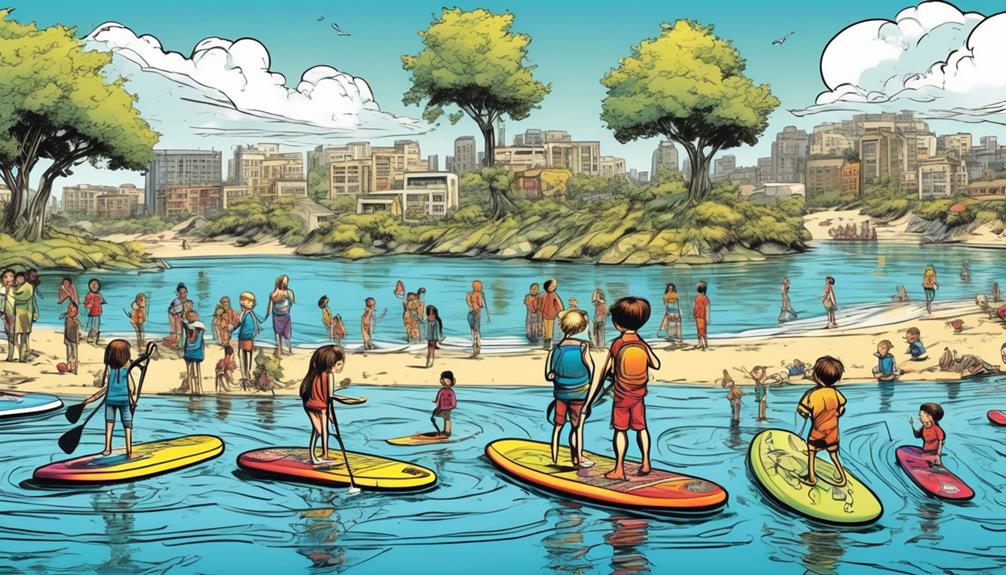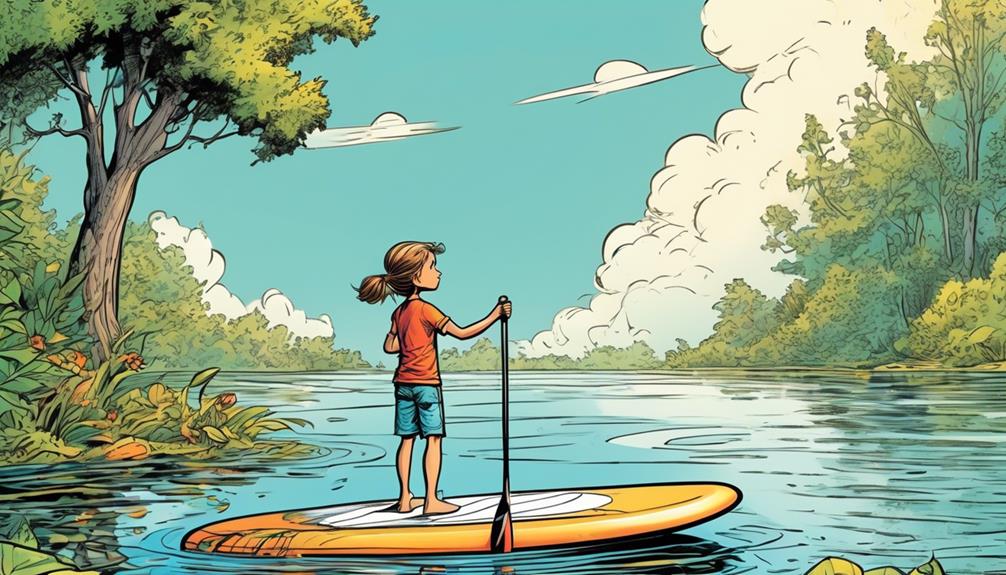Let's get real about inflatable paddle boards for your 9-year-old. It's not just about grabbing any board and hitting the water. If you're like me, you want your kid to have the best time while staying safe.
I've sifted through the data and trust me, size matters. For a lightweight champ, a board that's too big will be like trying to maneuver a tanker through a canal. Too small? They might as well be trying to balance on a surfboard.
From personal experience and diving into the facts, I've found that boards around 7-10 feet in length, with a width of about 30 inches, hit the sweet spot for stability, maneuverability, and fun. Think of it as the Goldilocks zone for young paddlers. You want a board that supports their weight (usually up to 120 pounds for this age group) without turning their paddle session into a swim meet.
So, if you're scrolling through options wondering what's best, keep these numbers in mind. I'll be breaking down why these dimensions work best, backed by real-world examples and some psychology on boosting your kid's confidence on the water.
Stick with me, and let's find that perfect board together.
Key Takeaways
- The ideal length for a paddleboard for a 9-year-old is between 7 to 9 feet.
- The recommended width for a paddleboard is between 28 to 30 inches.
- A board thickness of 4 to 6 inches ensures buoyancy and stability.
- Choosing the right weight capacity ensures safety, comfort, and room for growth.
Understanding Board Sizes

Selecting the right inflatable paddle board size for a 9-year-old can be a bit of a puzzle, but I've got you covered. Let's break it down with some real talk and numbers, because, let's face it, we all want that kiddo to have a blast while staying safe on the water.
First off, when it comes to length, you're looking at a sweet spot of 7 to 9 feet. Why? Because at this size, the board is big enough to provide the stability a young one needs but not so huge that they're wrestling with it rather than paddling. Imagine trying to maneuver a limo in a tight parking lot; that's what a too-large board feels like for them. On the flip side, a board that's too short is like riding a skateboard on a half-pipe for the first time—exciting but kinda risky.
Now, onto width. A board measuring 28 to 30 inches wide hits the mark perfectly. This width range offers a stable platform for the kiddo to balance on without making it a chore to paddle. It's like the difference between walking on a balance beam versus a sidewalk. One is definitely easier than the other, especially if you're just getting the hang of it.
Thickness is another game-changer. A board that's 4 to 6 inches thick will keep them floating high and dry, which is key for building confidence. Think of it as the difference between sitting in a rowboat versus a canoe; one feels a tad more secure than the other, right?
Let's not forget about the importance of a lightweight design. It's empowering for the young paddler to be able to carry their own gear. It's kind of like having their own backpack for the first time—there's a sense of pride and independence that comes with it.
And let's talk about features that make a difference. Adjustable paddles and soft top surfaces aren't just add-ons; they're essentials. Adjustable paddles can grow with them, and a soft top can be the difference between loving the sport and never wanting to try it again after a fall. It's the difference between riding a bike with and without training wheels. Both get you riding, but one offers a bit more comfort and confidence to the experience.
In essence, when you're picking out a paddle board for a 9-year-old, think stability, manageability, and comfort. These aren't just nice-to-haves; they're critical for ensuring the kid has a positive experience on the water. And isn't that what we all want? For them to fall in love with the sport and enjoy it safely? Trust me, getting these details right makes all the difference.
Evaluating Weight Capacities
So, you're on the lookout for the perfect paddleboard for your 9-year-old, and I get it, you're probably bombarded with a ton of options and not enough solid advice. Let's cut straight to the chase and talk about what really matters – weight capacities.
It's not the most thrilling topic, but trust me, getting this right is the difference between your child having a blast and a potential safety hazard.
First up, we've got Lightweight Boards. These are your go-to if your kid is under 60 lbs. From personal experience, they offer awesome maneuverability, which is super fun for kids. But, a word of caution, they mightn't be the best pick for beginners due to a slight compromise on stability. My cousin's kid started on one of these, and while he'd a bit of a wobbly start, it didn't take long before he was zipping around like a pro.
Moving on to Medium Weight Capacity Boards. Now, these are designed for kids who weigh between 60 to 100 lbs. They're like the Goldilocks of paddleboards – not too big, not too small, just right. They provide a solid balance between being easy to handle and stable enough to not send your kid for an unintended swim. A friend's daughter has been using one, and it's the perfect fit for her adventurous spirit without compromising her safety.
Then we've the Versatile Boards, which can handle up to 120 lbs. What's great about these is they're not just considering your kid's current weight but also the extra gear they might want to bring along. Think snacks, a water bottle, and essential safety equipment. And trust me, not having to leave the snacks behind is a big win for any kid. Plus, these boards offer enough room for growth, both in size and skill.
Finally, if you're looking at the long game, Growth Consideration Boards with a capacity of up to 150 lbs are where it's at. Opting for one of these means you're not shopping for a new board every couple of years as your child grows. It's a smart move financially and ensures your child continues to develop their paddleboarding skills on a board that grows with them.
Choosing the right board isn't just about ticking a box for safety; it's about investing in your child's continuous enjoyment and development in paddleboarding. You want a board that they won't just use but will love and grow with. And while it might seem like a lot to consider, focusing on the weight capacity can genuinely make all the difference.
Importance of Board Stability

So, you're on the hunt for the perfect paddleboard for your 9-year-old, right? Let's get straight to the point – board stability is what you should be zeroing in on, not just the weight capacity. From my own experiences and a bit of digging into the subject, it's clear that a stable board is a game-changer for young paddlers. It's not only about keeping them from taking an unexpected swim but also about building their confidence on the water. And who doesn't want to see their kid paddling with a big smile rather than a frown of frustration?
Here's the deal – wider boards are your best bet. Through trial and error, I've found that boards around 30 inches wide seem to hit the sweet spot between being stable enough to keep your kid upright and nimble enough for them to maneuver easily. This width provides a generous surface area, significantly enhancing balance. Plus, a 6-inch thick board has been a revelation in terms of buoyancy and stability. It's like upgrading from a rickety raft to a solid platform.
Now, let's talk about volume and shape. A board with a higher volume can support your child better, making it less likely they'll end up in the water. And the shape? Rounded boards have proven to be more stable than those sleek, racing-style ones. It's the difference between driving a sporty convertible and a sturdy SUV on a windy day.
In my quest for the perfect kid-friendly paddleboard, I've seen firsthand how a board around 30 inches wide and 6 inches thick transforms uncertainty into confidence. It's not just about staying dry; it's about giving them a platform where they can master the sport at their own pace.
Choosing the Right Accessories
So, you've got the perfect paddleboard size for your kiddo, and now you're in the market for the accessories that'll make their paddling journey not just awesome but also safe. Let me break it down for you with some real-talk and data that'll help you make informed choices.
First up, an Adjustable Paddle. I'm telling you, nothing beats finding a paddle that can adjust as your child grows. I've seen too many folks having to buy a new paddle every season because their kid hit a growth spurt. It's about being smart with your money. An adjustable, lightweight paddle means you're not only saving cash in the long run but also ensuring your kid always has the right-sized paddle for optimal performance.
Next on the list is the Personal Flotation Device (PFD). This is where you don't skimp. According to the U.S. Coast Guard, 76% of all boating fatalities in 2019 were due to drowning, and 84% of those victims weren't wearing a life jacket. That stat alone should have you prioritizing a child-specific PFD that's comfortable and won't restrict their movement. It's about making safety a habit they won't want to break.
Let's talk about the Waterproof Bag. You might wonder why it's so important. Well, think about it. Kids and their snacks are inseparable, and where else are they going to store their mini treasures found along the journey? A waterproof bag attached to their board gives them the independence to manage their snacks and hydration, and it teaches them responsibility for their belongings.
Lastly, the Ankle Leash. Ever seen a board float away because someone took a tumble? Not fun. A coiled leash is a game-changer. It keeps the board close without creating drag, making it easier for your kid to get back on board.
In my journey of paddling with my niece, I've seen firsthand how the right gear can instill confidence and enhance the experience. It's not just about throwing money at the most expensive gear but choosing wisely based on data and real-world use. So, when you're outfitting your young paddler, remember it's about safety, practicality, and long-term thinking.

